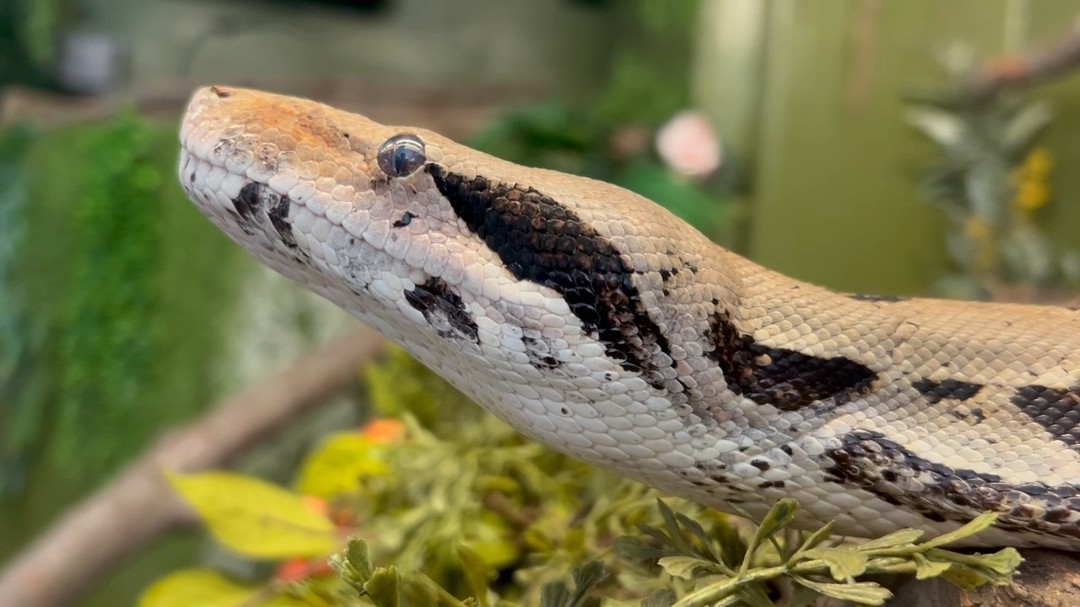- Introduction to Bubba and His New Home in the Discovery Barn
- Biological and Environmental Insights about Boa Constrictors
- Bubba’s Role in Educational Programs at the Zoo
- Conservation Issues Affecting Boa Constrictors
- Encouragement for Zoo Visitors to Learn about and Support Wildlife Conservation
Bubba, the boa constrictor, has become a beloved figure at the Animal Adventures LIVE program and the Zoomobile presentations. His presence offers both excitement and educational opportunities for visitors. Recently, Bubba has taken up residence in the Discovery Barn, sharing his space with other remarkable species like macaws and tortoises. Situated in the lower level of the barn, Bubba’s enclosure provides him with a comfortable environment where he can exhibit natural behaviors and contribute to educational programs, enriching the experience for zoo visitors.
Boa constrictors like Bubba are native to South America, inhabiting a range of environments from tropical rainforests to arid savannas. These snakes are solitary creatures, known for their impressive swimming and tree-climbing abilities. Although Bubba measures over 6 feet in length, boa constrictors can grow significantly larger, with some reaching up to 15 feet and weighing around 100 pounds. These physical attributes, combined with their unique coloration and pattern, make them a subject of fascination in zoological studies.
In the wild, boa constrictors play an important role as both predators and prey within their ecosystems. Their diet primarily consists of small to medium-sized mammals and birds, which they catch using ambush techniques followed by constriction. This behavior highlights their role in controlling populations of their prey, thereby maintaining ecological balance. However, human activities have posed significant threats to these snakes, reducing their populations in certain areas. The pet trade, in particular, has had a notable impact, as these snakes are often captured and sold, affecting their natural populations.
Bubba’s active participation in programs like Animal Adventures LIVE exemplifies the educational potential of zoos. These programs are structured to deliver engaging and informative content, allowing visitors to learn about the species and their ecological significance. Held daily at 11 am and 2:30 pm in the Beastro Lobby Auditorium, these sessions contribute to raising awareness of wildlife and biodiversity. By featuring animals like Bubba, the zoo illustrates the complex interactions within ecosystems and the broader implications of human actions on wildlife.
Conservation issues are pivotal in the discussion about boa constrictors. Habitat destruction, primarily due to urbanization and deforestation, has significantly reduced their natural habitats. Efforts to conserve these environments are crucial for preserving not only boa constrictors but also countless other species that coexist in these regions. Public awareness and education, as facilitated by zoo programs, play a key role in supporting conservation initiatives. Visitors are encouraged to delve into the intricacies of wildlife conservation, understanding the significance of maintaining biodiversity for ecological health.
When visiting the Discovery Barn, guests are encouraged to spend time observing Bubba and reflecting on the broader narratives of wildlife conservation that his presence underscores. Bubba’s role extends beyond mere exhibition; he symbolizes the ongoing efforts to educate the public about the importance of preserving natural environments and the species that inhabit them. Through interactive programs and engaging displays, the zoo invites all to become advocates for wildlife conservation, championing efforts that protect the delicate balance of nature and promote sustainable practices for future generations.
The presence of animals like Bubba in zoos fulfills an important educational role, providing tangible connections to the natural world and inspiring curiosity and care in visitors of all ages. As education and conservation go hand in hand, zoos serve as critical centers for learning and advocacy, where the public can gain insights into the intricate dynamics of ecosystems and the necessity of protecting the biodiversity we all share. Through understanding and action, we can work towards a future that values and preserves the incredible diversity of life on our planet.
*****
Source Description
NEW DISCOVERY BARN RESIDENT: If you’re a frequent audience member at our Animal Adventures LIVE program, you may already know Bubba! This boa constrictor is one of the rotating stars of the daily program and also can be seen in our Zoomobile presentations. You’ll now find Bubba residing on the lower level of the Discovery Barn across from the macaw and tortoise habitat.
Boa constrictors are solitary snakes that are native to South America and adept at swimming and climbing trees. While Bubba is a bit over 6 feet in length, his species can grow up to 15 feet and weigh up to 100 pounds. Threats to this species include the pet trade and hunting.
The next time you’re at the Discovery Barn, see if you can spot Bubba, who enjoys cozy corners for relaxing. Bubba will still make frequent appearances in the Animal Adventures LIVE program. You can catch this fun, free, and educational program daily at 11 am and 2:30 pm in the Beastro Lobby Auditorium!


